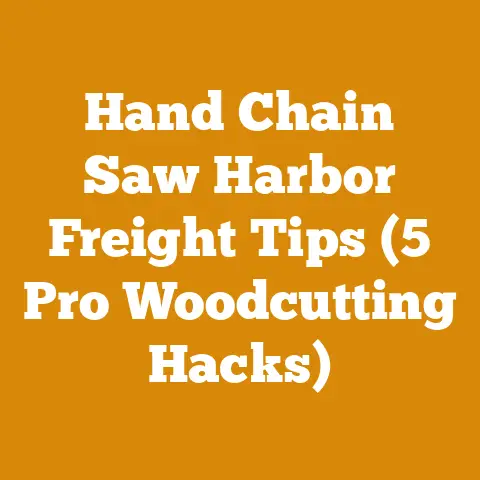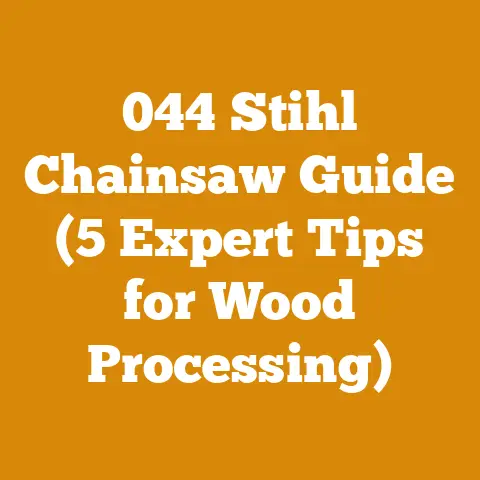3 Point Hitch Logging Winch: Top Models Compared (Expert Insights)
Isn’t it strange how something as seemingly simple as a logging winch can be both a back-saving marvel and a potential source of frustration on the woodlot?
I’ve learned over the years that the key lies in understanding the tools and matching them to the task.
Understanding 3-Point Hitch Logging Winches
What is a 3-Point Hitch Logging Winch?
A 3-point hitch logging winch is a powerful tool that attaches to the 3-point hitch of your tractor.
Its primary function is to pull logs out of the woods, often from areas inaccessible to the tractor itself.
This is achieved using a steel cable wound around a drum, powered by a hydraulic or mechanical system.
I find it invaluable for selective logging, thinning stands, and clearing fallen trees.
Why Use a Logging Winch?
The benefits of using a logging winch are numerous:
- Increased Efficiency: Winches significantly reduce the time and effort required to move logs.
I can move logs in minutes that would otherwise take hours with manual methods. - Improved Safety: By allowing you to pull logs from a distance, winches minimize the risk of injury from rolling logs or getting stuck in difficult terrain.
I’ve witnessed firsthand the accidents that can occur when trying to muscle logs without the proper equipment. - Enhanced Accessibility: Winches enable you to extract logs from steep slopes, dense forests, and wet areas where tractors can’t safely operate.
I’ve used winches to harvest timber from areas I previously thought were inaccessible. - Reduced Environmental Impact: Selective logging with a winch minimizes soil disturbance and damage to surrounding trees, promoting sustainable forestry practices.
I’m a strong advocate for responsible logging, and winches play a crucial role in that.
Types of Logging Winches
Logging winches come in two primary types:
- Mechanical Winches: These winches are powered directly by the tractor’s PTO (Power Take-Off) shaft.
They are generally more affordable and simpler in design, but they may offer less precise control and require more operator skill.
I started with a mechanical winch and found it reliable, but it did require a bit of a learning curve. - Hydraulic Winches: These winches are powered by the tractor’s hydraulic system.
They offer smoother operation, more precise control, and often have features like automatic braking and adjustable pulling force.
Hydraulic winches are my preferred choice for their ease of use and advanced features.
Key Features to Consider
When selecting a 3-point hitch logging winch, consider these key features:
- Pulling Capacity: This is the maximum weight the winch can pull.
Choose a winch with a pulling capacity that exceeds the weight of the logs you’ll be handling.
I always recommend erring on the side of caution and choosing a winch with a higher capacity than you think you’ll need. - Cable Length and Diameter: Longer cables allow you to reach logs farther away from the tractor.
Thicker cables are stronger and more durable.
I prefer cables that are at least 150 feet long and have a diameter of 3/8 inch or greater. - Drum Capacity: This refers to the amount of cable the winch drum can hold.
Ensure the drum capacity is sufficient for the cable length you intend to use. - Braking System: A reliable braking system is essential for safety.
Look for winches with automatic brakes that engage when the pulling force is released.
I’ve had a few close calls with winches that had inadequate braking systems, so this is a feature I take very seriously. - Control System: Consider the type of control system.
Some winches have simple manual controls, while others offer remote control options.
Remote controls allow you to operate the winch from a safe distance, which is particularly useful when working alone. - Build Quality: Choose a winch made from high-quality materials with robust construction.
Look for features like reinforced frames, heavy-duty bearings, and durable finishes.
I’ve seen winches fail prematurely due to poor construction, so it’s worth investing in a well-built model. - Fairlead: The fairlead guides the cable onto the drum and reduces wear and tear.
Look for a fairlead with rollers or smooth surfaces to minimize friction.
Top Models Compared
Now, let’s dive into a comparison of some of the top 3-point hitch logging winches on the market.
I’ve included models from various manufacturers, considering different price points and feature sets.
1. Wallenstein FX85 Hydraulic Winch
- Pulling Capacity: 8,500 lbs
- Cable Length: 164 ft (1/2″ diameter)
- Type: Hydraulic
- Key Features: Automatic brake, adjustable clutch, remote control option, heavy-duty construction.
My Experience: The Wallenstein FX85 is a powerhouse.
I’ve used it extensively for pulling large hardwoods, and it has never let me down.
The hydraulic system is smooth and responsive, and the automatic brake provides excellent safety.
The remote control is a game-changer when working alone.
It’s a premium winch, but the performance and durability justify the investment.
Pros:
- High pulling capacity
- Smooth hydraulic operation
- Excellent braking system
- Remote control option
- Durable construction
Cons:
- Higher price point
- Relatively heavy
2. Farmi JL501 Mechanical Winch
- Pulling Capacity: 11,000 lbs
- Cable Length: 164 ft (3/8″ diameter)
- Type: Mechanical
- Key Features: Simple design, robust construction, large drum capacity.
My Experience: The Farmi JL501 is a workhorse of a mechanical winch.
It’s simple, reliable, and incredibly strong.
I appreciate its robust construction and large drum capacity.
While it lacks the finesse of a hydraulic winch, it gets the job done efficiently.
It’s a great option for those who prefer a straightforward, dependable tool.
Pros:
- High pulling capacity
- Simple and reliable design
- Robust construction
- Large drum capacity
- More affordable than hydraulic winches
Cons:
- Less precise control than hydraulic winches
- No remote control option
3. Norse 180 Mechanical Winch
- Pulling Capacity: 4,000 lbs
- Cable Length: 130 ft (5/16″ diameter)
- Type: Mechanical
- Key Features: Compact design, lightweight, affordable.
My Experience: The Norse 180 is an excellent option for smaller tractors and lighter logging tasks.
I’ve used it for thinning stands and clearing brush, and it’s proven to be a valuable tool.
Its compact design and lightweight make it easy to maneuver in tight spaces.
While its pulling capacity is lower than other models, it’s still a capable winch for its intended purpose.
Pros:
- Compact and lightweight
- Affordable
- Easy to maneuver
- Suitable for smaller tractors
Cons:
- Lower pulling capacity
- No remote control option
4. Titan Attachments 3 Point Tractor Logging Skidding Winch
- Pulling Capacity: 6,600 lbs
- Cable Length: 131 ft (3/8″ diameter)
- Type: Mechanical
- Key Features: Affordable, simple design, integrated skidding plate.
My Experience: The Titan Attachments winch is a budget-friendly option that offers good value for the price.
I’ve found it to be a reliable winch for general logging tasks.
The integrated skidding plate is a nice feature that helps to protect the winch and the logs.
While it may not have all the bells and whistles of more expensive models, it’s a solid performer for the price.
Pros:
- Affordable
- Simple design
- Integrated skidding plate
- Good value for the price
Cons:
- Lower pulling capacity compared to some models
- No remote control option
5. Uniforest 35H Hydraulic Winch
- Pulling Capacity: 7,700 lbs
- Cable Length: 164 ft (3/8″ diameter)
- Type: Hydraulic
- Key Features: Automatic brake, adjustable clutch, remote control option, high-quality construction.
My Experience: The Uniforest 35H is a top-of-the-line hydraulic winch that offers exceptional performance and reliability.
I’ve been impressed with its smooth operation, powerful pulling capacity, and durable construction.
The remote control is a must-have for anyone working alone in the woods.
It’s a significant investment, but it’s worth it for the long-term benefits.
Pros:
- High pulling capacity
- Smooth hydraulic operation
- Excellent braking system
- Remote control option
- High-quality construction
Cons:
- High price point
- Relatively heavy
Model Comparison Table
To summarize, here’s a table comparing the key features of each model:
Price Ranges: \$ (Budget-Friendly), \$\$ (Affordable), \$\$\$ (Mid-Range), \$\$\$\$ (Premium)
Factors Influencing Your Choice
Choosing the right logging winch depends on several factors:
- Tractor Size and Horsepower: Ensure the winch is compatible with your tractor’s size and horsepower.
A winch that is too large or powerful can overload your tractor and cause damage. - Type of Logging You Do: Consider the type of logging you’ll be doing.
For small-scale thinning and clearing, a smaller winch may suffice.
For larger-scale logging operations, a more powerful winch is necessary. - Terrain: The terrain you’ll be working in will also influence your choice.
For steep slopes and difficult terrain, a winch with a high pulling capacity and a reliable braking system is essential. - Budget: Logging winches range in price from a few hundred dollars to several thousand dollars.
Set a budget and choose a winch that offers the best value for your money. - Personal Preferences: Consider your personal preferences and experience level.
If you’re new to logging, a simpler mechanical winch may be a good starting point.
If you’re an experienced logger, you may prefer the advanced features of a hydraulic winch.
Tips for Safe and Efficient Winching
Operating a logging winch safely and efficiently requires careful planning and execution.
Here are some tips to keep in mind:
- Read the Owner’s Manual: Before operating any logging winch, thoroughly read the owner’s manual.
Pay attention to safety instructions, operating procedures, and maintenance requirements.
I can’t stress this enough – understanding your equipment is crucial for safe operation. - Wear Appropriate Safety Gear: Always wear appropriate safety gear, including a hard hat, safety glasses, gloves, and sturdy boots.
I’ve seen too many injuries that could have been prevented with proper safety gear. - Inspect the Winch and Cable: Before each use, inspect the winch and cable for any signs of damage.
Replace worn or damaged cables immediately.
A frayed cable can snap under load, causing serious injury. - Plan Your Pull: Before starting the pull, carefully plan your route and identify any potential hazards.
Ensure the area is clear of people and obstacles.
I always take a few minutes to assess the situation before starting the winch. - Use Proper Choking Techniques: Use proper choking techniques to secure the log to the cable.
Avoid wrapping the cable directly around the log, as this can damage the cable and the log.
Use a choker chain or a logging sling instead. - Maintain a Safe Distance: Maintain a safe distance from the winch and the cable during operation.
Never stand directly behind the winch or in the path of the cable.
I always try to position myself to the side of the winch, where I’m less likely to be hit by a snapping cable. - Use a Snatch Block: A snatch block can be used to redirect the pulling force and increase the winch’s pulling capacity.
I often use a snatch block when pulling logs around obstacles or up steep slopes. - Avoid Overloading the Winch: Never exceed the winch’s rated pulling capacity.
Overloading the winch can damage the winch and create a dangerous situation. - Use Communication Signals: If you’re working with a partner, establish clear communication signals.
This will help to prevent misunderstandings and ensure safe operation. - Maintain Your Winch: Regularly maintain your winch according to the manufacturer’s instructions.
This will help to ensure its longevity and reliability.
I always clean and lubricate my winch after each use.
Real-World Examples and Case Studies
To illustrate the practical applications of logging winches, here are a few real-world examples and case studies:
Case Study 1: Selective Logging on a Steep Slope
A small-scale logger in the Appalachian Mountains needed to selectively harvest timber from a steep slope.
The terrain was too rugged for a skidder, and manual methods would have been too time-consuming and dangerous.
The logger used a Wallenstein FX85 hydraulic winch to pull the logs up the slope to a landing area.
The winch’s high pulling capacity and reliable braking system allowed the logger to safely and efficiently harvest the timber while minimizing soil disturbance.
Case Study 2: Clearing Fallen Trees After a Storm
A landowner in the Pacific Northwest had several large trees fall across their driveway after a severe storm.
The trees were too large to move manually, and a skidder would have damaged the driveway.
The landowner used a Farmi JL501 mechanical winch to pull the trees off the driveway.
The winch’s simple design and robust construction made it easy to use, even for someone with limited experience.
Example 1: Thinning a Pine Plantation
I recently used a Norse 180 mechanical winch to thin a dense pine plantation.
The trees were closely spaced, making it difficult to maneuver a tractor.
The winch’s compact design and lightweight made it easy to pull the trees out of the plantation without damaging the remaining trees.
Example 2: Salvaging Timber from a Wet Area
I once used a Uniforest 35H hydraulic winch to salvage timber from a wet area that was inaccessible to my tractor.
The winch’s remote control allowed me to operate the winch from a safe distance while standing on dry ground.
This allowed me to harvest the timber without getting stuck in the mud.
Advanced Techniques and Best Practices
For experienced loggers and wood processors, here are some advanced techniques and best practices to consider:
- Using Multiple Winches: In some situations, it may be beneficial to use multiple winches to pull logs.
This can increase the pulling capacity and allow you to move larger logs. - Combining Winches with Skidders: Winches can be used in conjunction with skidders to improve efficiency.
The winch can be used to pull logs to a central location, where the skidder can then transport them to the landing area. - Using Winches for Uphill and Downhill Logging: Winches can be used for both uphill and downhill logging.
When logging uphill, the winch can be used to pull the logs up the slope.
When logging downhill, the winch can be used to control the descent of the logs. - Minimizing Soil Disturbance: When using a logging winch, it’s important to minimize soil disturbance.
This can be achieved by using proper choking techniques, avoiding unnecessary dragging, and using a winch with a low ground pressure. - Protecting Residual Trees: When selectively logging with a winch, it’s important to protect the residual trees.
This can be achieved by carefully planning your pulls, using tree protectors, and avoiding unnecessary contact with the trees. - Optimizing Cable Angle: The angle of the cable can affect the winch’s pulling capacity.
Ideally, the cable should be pulled in a straight line.
If the cable is pulled at an angle, the pulling capacity will be reduced.
Use a snatch block to optimize the cable angle. - Layering Cable on the Drum: When spooling cable onto the drum, it’s important to layer the cable evenly.
This will help to prevent the cable from bunching up and causing damage. - Using Synthetic Ropes: Synthetic ropes are becoming increasingly popular as a replacement for steel cables.
Synthetic ropes are lighter, stronger, and easier to handle than steel cables.
However, they are also more expensive.
Maintaining Your Logging Winch
Proper maintenance is essential for ensuring the longevity and reliability of your logging winch.
Here are some maintenance tips:
- Regularly Inspect the Winch: Regularly inspect the winch for any signs of damage or wear.
Pay particular attention to the cable, drum, brakes, and controls. - Lubricate Moving Parts: Lubricate all moving parts according to the manufacturer’s instructions.
This will help to reduce friction and prevent wear.
I use a high-quality grease specifically designed for logging equipment. - Clean the Winch: Clean the winch after each use to remove dirt, debris, and moisture.
This will help to prevent corrosion and extend the life of the winch. - Store the Winch Properly: Store the winch in a dry, protected location when not in use.
This will help to prevent rust and corrosion. - Replace Worn Parts: Replace worn parts as needed.
This will help to prevent further damage and ensure the winch operates safely and efficiently. - Service the Winch Regularly: Have the winch serviced by a qualified technician on a regular basis.
This will help to identify any potential problems and ensure the winch is operating at peak performance.
Safety Standards and Regulations
It’s important to be aware of the safety standards and regulations that apply to logging winches.
These standards and regulations are designed to protect workers and prevent accidents.
Some relevant standards and regulations include:
- OSHA (Occupational Safety and Health Administration) Regulations: OSHA has specific regulations for logging operations, including the use of logging winches.
These regulations cover topics such as training, personal protective equipment, and safe operating procedures. - ANSI (American National Standards Institute) Standards: ANSI has developed standards for logging equipment, including logging winches.
These standards cover topics such as design, construction, and testing. - Local and State Regulations: Many local and state governments have their own regulations for logging operations.
These regulations may cover topics such as permits, environmental protection, and safety.
It’s your responsibility to be aware of and comply with all applicable safety standards and regulations.
Contact your local OSHA office or forestry agency for more information.
The Future of Logging Winches
The future of logging winches is likely to be characterized by increased automation, improved safety features, and greater efficiency.
Some emerging trends include:
- Remote Control Technology: Remote control technology is becoming increasingly sophisticated, allowing operators to control winches from a greater distance and with greater precision.
- GPS and Mapping Technology: GPS and mapping technology can be used to plan logging operations and track the location of logs.
This can improve efficiency and reduce the risk of accidents. - Electric Winches: Electric winches are becoming more popular due to their quiet operation, low emissions, and ease of use.
- Synthetic Ropes: Synthetic ropes are replacing steel cables in many applications due to their lighter weight, greater strength, and improved handling characteristics.
- Smart Winches: Smart winches are equipped with sensors and software that can monitor the winch’s performance and provide real-time feedback to the operator.
This can help to prevent overloading and other safety hazards.
As technology continues to advance, logging winches will become even more powerful, efficient, and safe.
Final Thoughts
Choosing the right 3-point hitch logging winch is a critical decision that can significantly impact the efficiency and safety of your logging operations.
By considering the factors outlined in this guide, you can make an informed decision and select a winch that meets your specific needs and budget.
Remember to prioritize safety, follow proper operating procedures, and maintain your winch regularly.
With the right winch and a commitment to safety, you can efficiently and sustainably harvest timber for years to come.
My hope is that this guide has provided you with the knowledge and insights you need to choose the perfect 3-point hitch logging winch for your operation.
Happy winching!
Next Steps:
- Assess Your Needs: Carefully evaluate your tractor size, logging tasks, terrain, and budget.
- Research Models: Use the model comparison table and my experiences to narrow down your options.
- Read Reviews: Read online reviews and talk to other loggers to get their opinions.
- Visit Dealers: Visit local dealers to see the winches in person and ask questions.
- Make Your Decision: Choose the winch that best meets your needs and budget.
- Practice and Learn: Before using your new winch, practice in a safe and controlled environment.
- Stay Safe: Always prioritize safety when operating your logging winch.






